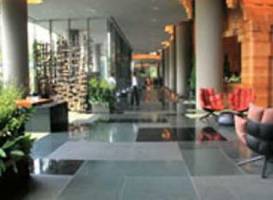The Unbreakable Bond
01 Mar 2019

Mapei’s Keralastic and Keralastic T are two-component, solvent and water-free adhesives that are flexible and waterproof.
Kerabond T or Keralastic is a high-performance, two-part system, second-generation flexible acrylic latex additive. Keralastic is used to enhance the performance of Kerabond T – a premium-grade, medium-bed and thin-set mortar. This system has exceptional bond strength, flexural strength, elongation and freeze or thaw durability.
The adhesives
Keralastic and Keralastic T are two-component, solvent and water-free adhesives that are flexible and waterproof. They are made up of a polyurethane base (component A) and a special hardener (component B). On mixing the two components together, the result is a paste with the following properties:
Good workability.
- Excellent durability and resistant to ageing.
- Perfect adhesion to all surfaces used in building.
- Hardens by chemical reaction without shrinkage (until it becomes highly resistant).
- High deformability.
- In the case of Keralastic T, it is highly thixotropic as it can be applied vertically without slump and without letting heavy or large tiles slip. The slipping strength is in compliance with EN 1308.
High resistance
Kerabond T is a grey or white powder composed of cement, fine-grade, synthetic resins and special admixtures formulated in the MAPEI Research and Development Laboratories. Mixed with water, Kerabond T becomes an easily trowellable mortar with good bonding strength, low slump and high grab so that it can be applied vertically without sagging, even holding heavy tiles. It is possible to install from the top towards the bottom without using spacer pegs. Kerabond T hardens without noticeable shrinkage to become extremely resistant, adhering perfectly to all the conventional materials used in construction.
Compliance
Keralastic T – EN12004 as R2, R2T and ISO 13007-1 as R2, R2T
Kerabond T - EN 12004 as C1T and ISO 13007-1 as C1T.
Features and benefits
High-performance bond.
Best for most difficult tiles, substrates and conditions.
Uses
- Most interior and exterior residential and commercial installations on floors, walls and ceilings.
- Installation of ceramic and porcelain tile, glass tile, quarry tile, pavers, saltillo tile and most types of marble, granite and natural stone.
- Conventional renders or cement mortar walls.
- Ordinary concrete slabs or reinforced floating slabs, provided they are sufficiently well-aged
- and dry.
- Gypsum supports and anhydrite screeds as long as they are first treated with a primer.
- Bonding ceramic tiles, stone material and all types of mosaics in showers and on sheets used for prefabricated bathrooms.
- Bonding ceramic tiles and mosaics on wooden work surfaces or in kitchens in order to achieve a waterproof substrate.
- Bonding ceramic tiles, stone material and mosaics on balconies, external terraces domes or flat roofs subject to foot traffic.
- Bonding natural stones and reconstructed stone (marble of every type, slate, etc) also subject to movement and size variation due to the absorption of water (class C of size stability according to MAPEI standards).
- Bonding ceramic tiles and stone material on surfaces subject to vibrations and deflections.
Related Stories

